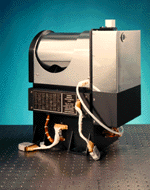 |
TES works on the concept that different types of compounds will take on different temperatures when exposed to the same amount of sunlight. For example, water in the ocean always remains cooler than the hot sand on the beach. The thermal data radioed back to Earth from TES will allow scientists to determine the general mineral composition of patches of ground as small as 9.0 square kilometers (3.5 square miles) in area. Scientists will gather this type of data over many days in order to conduct a planet-wide mineral survey of Mars. In addition, TES will also scan the Martian atmosphere to provide data for the study of the clouds and weather.
Many scientists hope that TES will ultimately yield clues into the location of clays containing carbonate minerals. Although no liquid water exists on Mars today, carbonate deposits might indicate areas that could have been shorelines long ago in Martian history. Future missions to Mars might begin their search for fossil remains of life in areas identified by TES data.